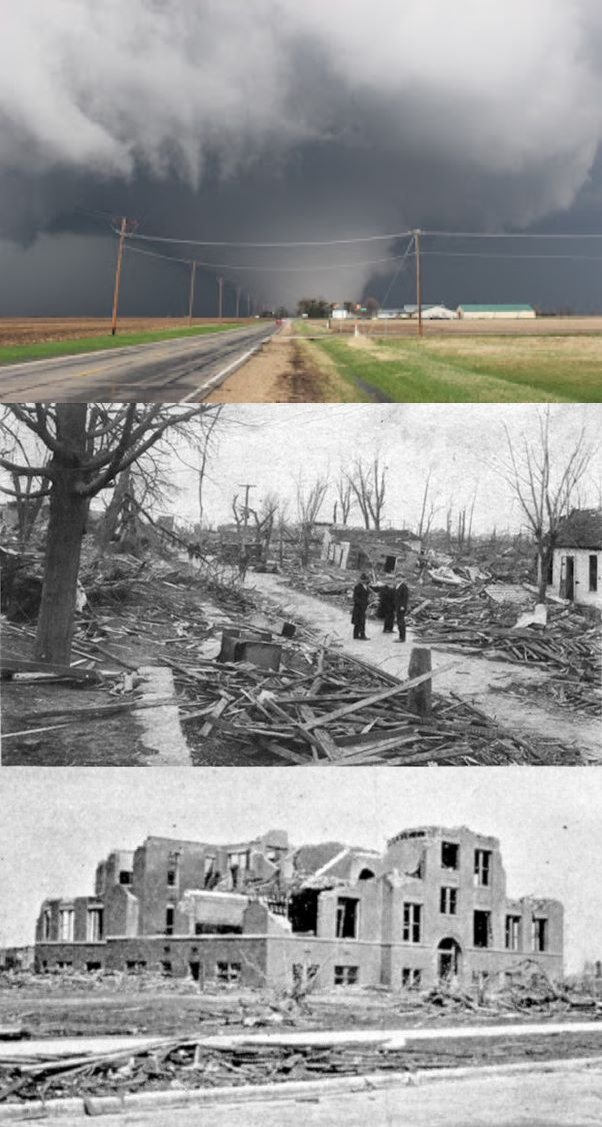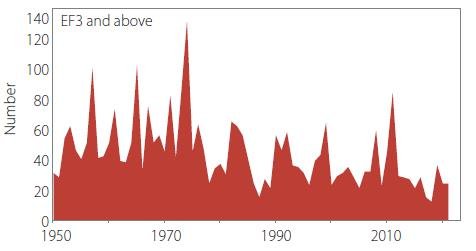By Physicist Dr. Ralph Alexander
After a flurry of tornadoes swarmed the central U.S. this March, the media were quick to fall into the trap of linking the surge to climate change, as often occurs with other forms of extreme weather. But there is no evidence that climate change is causing tornadoes to become more frequent and stronger, any more than hurricanes are increasing in strength and number, as I discussed in my previous post.
Indeed, there are ample examples of past tornadoes just as or more violent and deadly than today’s, but conveniently ignored by believers in the narrative that weather extremes are on the rise.
Like hurricanes, tornadoes are categorized according to wind speed, using the Fujita Scale going from EF0 to EF5 (F0 to F5 before 2007); EF5 tornadoes attain wind speeds up to 480 km per hour (300 mph). More terrifying than hurricanes because they often arrive without warning, tornadoes also have the awesome ability to hurl cars, structural debris, animals and even people through the air.

In the U.S., tornadoes cause about 80 deaths and more than 1500 injuries per year. The deadliest episode of all time in a single day was the “tri-state” outbreak in 1925, which killed over 700 people and resulted in the most damage from any tornado outbreak in U.S. history. The photo montage on the right shows one of the 12 or more tornadoes observed in Missouri, Illinois and Indiana approaching a farm (top); some of the 154 city blocks obliterated in Murphysboro, Illinois (middle); and the wreckage of Murphysboro’s Longfellow School, where 17 children were killed (bottom). Unlike the narrow path of most tornadoes, the swath of destruction wrought by the main F5 tornado was up to 2.4 km (1.5 miles) wide. Amazingly, the ferocious storm persisted for a distance of 353 km (219 miles) in its 3 ½-hour lifetime. Together with smaller F2, F3 and F4 tornadoes, the tri-state tornado destroyed or almost destroyed numerous towns. Another 33 schoolchildren died in De Soto, Illinois when their school collapsed. De Soto’s deputy sheriff was sucked into the funnel cloud, never to be seen again.
Newspapers of the day chronicled the devastation. United Press described how:
a populous, prosperous stretch of farms, villages and towns … suddenly turned into an inferno of destruction, fire, torture and death.
The Ellensburg Daily Record reported that bodies were carried as far as a mile by the force of the main tornado.
Over three successive days in May 1953, at least 10 different U.S. states were struck by an outbreak of more than 33 tornadoes, the deadliest being an F5 tornado that carved a path directly though the downtown area of Waco, Texas (photo immediately below). Believing falsely that their city was immune to tornadoes, officials had not insisted on construction of sturdy buildings, many of which collapsed almost immediately and buried their occupants.
The same day, a powerful F4 tornado hit the Texas city of San Angelo, causing catastrophic damage. As mentioned in the accompanying newspaper article below, an American Associated Press correspondent reported “a scene of grotesque horror” in Waco and described how San Angelo’s business area was “strewn with kindling wood.”

June that year saw a sequence of powerful tornadoes wreak havoc across the Midwest and New England, the latter being well outside so-called Tornado Alley. An F5 tornado in Flint, Michigan (upper photo in figure below) and an F4 tornado in Worcester, Massachusetts (lower photo) each caused at least 90 deaths and extensive damage. The accompanying newspaper article, in Australia’s Brisbane Courier-Mail, mentions how cars were “whisked about like toys.”

Nature’s wrath was on display again in the most ferocious tornado outbreak ever recorded, spawning a total of 30 F4 or F5 tornadoes – the so-called Super Outbreak – in April 1974. A total of 148 tornadoes of all strengths struck 13 states in Tornado Alley and the Canadian province of Ontario over two days; their distribution and approximate path lengths are depicted in the left panel of the next figure.

The photos on the right illustrate the massive F5 tornado, the worst of the 148, that bore down on Xenia, Ohio (population 29,000, top) and the resulting damage (middle and bottom). The Xenia tornado was so powerful that it tossed freight trains on their side, and even dropped a school bus onto a stage where students had been practicing just moments before. Wrote the Cincinatti Post of the devastation:
Half of Xenia is gone.
In Alabama, two F5 tornadoes, out of 75 that struck the state, hit the town of Tanner within 30 minutes; numerous homes, both brick and mobile, were chewed up or swept away. In Louisville, Kentucky, battered by an F4 tornado, a Navy veteran who lost his home lamented in the Louisville Times that:
only Pearl Harbor was worse.
In all, the Super Outbreak caused 335 fatalities and over 6,000 injuries.
The following figure shows that the annual number of strong tornadoes (EF3 or greater) in the U.S. has declined dramatically over the last 72 years. In fact, the average number of strong tornadoes annually from 1986 to 2017 – a period when the globe warmed by about 0.7 degrees Celsius (1.3 degrees Fahrenheit) – was 40% less than from 1954 to 1985, when warming was much less. That turns the extreme weather caused by climate change narrative on its head.

Next: No Evidence That Extreme Weather on the Rise: A Look at the Past – (3) Floods

